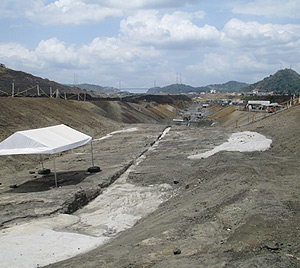By Aaron Wood | PCP PIRE Project Manager
The Panama Canal has offered a unique window on the sedimentary rock record of the New World Tropics for many generations of scientists, but basic questions remain about the geologic strata of the Panama Canal Basin and their fossil content. The exceptional work of geologists at the U.S. Geological Survey and the former Panama Canal Company laid the foundation for what we know about the geology of the Panama Canal Basin. The ongoing expansion of the Canal, however, provides us with new evidence with which we can test the hypotheses of these previous workers and build a much richer picture of the ancient environments of Panama.

At the beginning of 2013, Pastora Franceschi and Derek Irving, geologists with the Panama Canal Authority (ACP), contacted PCP PIRE about interesting plant fossils that had been uncovered during excavation of the new Pacific Access Channel (PAC). Ms. Franceschi and Mr. Irving kindly invited me, along with the PCP PIRE interns, to survey the exposures for additional fossils and to provide an independent assessment of the geology of the PAC area. This was a fantastic opportunity. The combination of fresh horizontal surfaces (i.e., map views) and vertical exposures (i.e., cross-sectional views) gave us a full three-dimensional perspective on the relationship of rock strata, fossils and paleoenvironments that we had not seen before.
Without that important phone call from Ms. Franceschi, the interns and I would never have discovered the well-preserved fossil plant assemblage of the Pedro Miguel Formation. Nor would we have collected rare leaf cuticles (i.e., the original plant tissue!) that are being used for paleobotanical work and reconstructing carbon dioxide levels in Earth’s atmosphere 20 million years ago. Mr. Irving’s generosity with his time and expertise led to the discovery of undocumented paleoenvironments in the Cucaracha Formation, including sedimentary evidence for a wide braided river system. Preliminary results from these new discoveries were presented at meetings of the Botanical Society of America and the Geological Society of America by PCP-PIRE interns and graduate students.
International partnerships, like our relationship with ACP, are absolutely crucial for the success of PCP PIRE’s research goals. I am incredibly thankful for the opportunities that Ms. Franceschi, Mr. Irving and other ACP employees made possible for PCP-PIRE interns, students and researchers during 2013. I look forward to a new year of exciting collaborations and discoveries.
Links to abstracts presented in meetings:
Miocene Depositional Environments of The Southeastern Gaillard Cut, Panama Canal, Republic of Panama
Insights into the middle Miocene Climatic Optimum from a Neotropical leaf assemblage
Por Aaron Wood | PCP PIRE Gerente de Proyecto
El Canal de Panamá ha ofrecido una ventana única en el registro de las rocas sedimentarias de los trópicos del Nuevo Mundo para muchas generaciones de científicos, pero aun quedan preguntas básicas sobre los estratos geológicos de la Cuenca del Canal de Panamá y su contenido fósil. El trabajo excepcional de geólogos del Servicio Geológico de EE.UU. y de la antigua Compañía del Canal de Panamá sentó las bases de lo que sabemos sobre la geología de la cuenca del Canal de Panamá. La continua expansión del Canal, sin embargo, nos proporciona nueva evidencia con la que podemos probar la hipótesis que personas anteriores tenían y construir una imagen mucho más rica de los ambientes antiguos de Panamá.

A principios de 2013, Pastora Franceschi y Derek Irving, los geólogos de la Autoridad del Canal de Panamá (ACP), contactaron al PCP PIRE sobre los fósiles de interesantes plantas que habían sido descubiertos durante la excavación del nuevo cauce de acceso del Pacífico (PAC). La Sra. Franceschi y el Sr. Irving me invitaron amablemente, junto con los pasantes del PCP PIRE para estudiar los afloramientos de fósiles adicionales y proporcionar una evaluación independiente de la geología de la zona de PAC. Esta fue una oportunidad fantástica. La combinación de superficies horizontales frescas (por ejemplo, vista de mapa) y exposiciones verticales (es decir, vistas transversales) nos dio una perspectiva tridimensional completa sobre la relación de los estratos de roca, fósiles y paleoambientes que no habíamos visto antes.
Sin esa llamada importante de la Sra. Franceschi, los pasantes y yo nunca habríamos descubierto el conjunto de plantas fósiles bien conservados de la formación Pedro Miguel. Tampoco hubieramos recogido las cutículas de hojas raras (es decir, el tejido de la planta original!) que están siendo utilizados para el trabajo de paleobotánica y reconstruir los niveles de dióxido de carbono en la atmósfera de la Tierra hace 20 millones de años. La generosidad del Sr. Irving con su tiempo y experiencia llevó al descubrimiento de paleoambientes indocumentados en la Formación Cucaracha, incluyendo evidencia sedimentaria de un sistema fluvial amplio. Los resultados preliminares de estos nuevos descubrimientos fueron presentados en las reuniones de la Sociedad Botánica de América y la Sociedad Geológica de América por los pasantes del PCP PIRE y estudiantes de posgrado.
Las colaboraciones internacionales, como la que existe con la ACP, son absolutamente cruciales para el éxito de los objetivos de investigación del PCP PIRE. Estoy muy agradecido por las oportunidades que la Sra. Franceschi, el Sr. Irving y otros empleados de la ACP han dado a pasantes, estudiantes e investigadores del PCP PIRE durante el 2013. Espero con interés un nuevo año de colaboraciones y descubrimientos interesantes.
Enlaces a los resúmenes presentados en conferencias
Miocene Depositional Environments of The Southeastern Gaillard Cut, Panama Canal, Republic of Panama
Insights into the middle Miocene Climatic Optimum from a Neotropical leaf assemblage